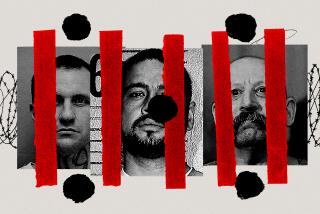Serial killer Israel Keyes was mistakenly given a razor blade
- Share via
Jail couldn’t keep Israel Keyes out of trouble, not even with himself.
The prolific serial killer had already been caught and jailed by authorities months ago for his final butchery -- the kidnapping and slaying of 18-year-old Anchorage barista Samantha Koenig, one of the eight people he’d alluded to killing over years of attacks across the country.
But a new report released this week by the Alaska Department of Corrections detailed the extent to which the 34-year-old construction worker continued to cause trouble with his captors even as he cooperated with investigators working to discover whom he’d killed.
Keyes killed himself on Dec. 2. And on Wednesday, officials confirmed he had been given the razor that he ultimately used, though much remains murky.
Keyes was already being held away from other prisoners when, at an Anchorage court hearing in May in the Koenig case, he leaped over a railing to the spectators gallery before he was shocked with a stun gun and recaptured. “Kill him!” someone shouted during the struggle.
The escape attempt caught his interrogators off guard; he’d already been regaling them with tales of his killings, which he carefully doled out to his questioners without asking for protection from the death penalty, which had loomed over his prosecution.
“His reaction was, ‘Even if there was a 1% chance that I was going to get out of there, why not try it?’ ” Kelvin Feldis, chief of the criminal division for the U.S. attorney’s office in Alaska, previously told the Los Angeles Times.
After the escape attempt, Keyes was placed under “enhanced security measures” that included full restraints, two-guard escorts outside his cell, limited access to pencils and razors, and daily strip searches, the corrections department said in its Wednesday announcement about Keyes’ confinement.
Those measures did not stop Keyes from fashioning an improvised handcuff key; he was caught with a paper clip wrapped in dental floss on Sept. 11, the department said.
As punishment, a prison board decided, Keyes would have to go 15 days without certain personal property. It was four days after that punishment began on Nov. 28 that jailors discovered Keyes’ body in his cell.
His body was found with bloody, crumpled pages of morbid poetry Keyes had written about American life and about women, which was released by the Federal Bureau of Investigation last week.
Beth Ipsen, a spokeswoman for the Alaska State Troopers, which initially investigated Keyes’ suicide, previously told The Times that Keyes cut his left wrist after he embedded the blade from a disposable razor in the end of a pencil, which he used as a handle. He also strangled himself with a sheet.
He had been given that blade by accident, the department of corrections said Wednesday.
But further details have been unclear because of in a lack of transparency, caused by limitations of state law and security concerns, officials said.
Kaci Schroeder, a spokeswoman for the Alaska Department of Corrections, said the department would not comment on when Keyes had accidentally been given the razor or why officials hadn’t gotten the razor back.
Investigators previously told the The Times that Keyes had gotten a weekly subscription to the New York Times while in jail and had been temporarily placed on suicide watch months before his death, which jail officials have declined to confirm.
State officials also denied a public-records request by the Associated Press in January for more information about the razor. The officials cited prisoner privacy and “the ground that the only investigation performed was conducted at the direction of Assistant Atty. Gen. John K. Bodick in anticipation of litigation and is thus protected from release by the attorney-client privilege.”
No lawsuits have been reported against Alaska officials.
Members of Keyes’ conservative Christian family were last reported to have been staying at the Church of Wells in Texas, which preaches strict spiritual separation from mainstream churches. Keyes had visited them after killing Koenig and shortly before his capture, where he was reported to have been crying and ranting about his atheism.
In a previous interview with the Anchorage Daily News, Bryan Brandenburg, superintendent of facilities with the state Department of Corrections, had alluded to Keyes’ time on suicide watch.
“He had intended to hurt himself. We discovered that and put him on suicide precautions,” Brandenburg told the newspaper. “At some point, it was determined he was no longer suicidal. ... Our staff did a fantastic job in preventing maybe an earlier tragedy.”
Keyes’ death devastated the investigation into his previous killings, investigators previously told The Times; he still hadn’t given the names of all his victims and the locations of their remains. In a meeting with investigators days before his suicide, he had continued to open up about what he’d done.
“‘So your intent is still to tell us everything, right?’” Anchorage Police Officer Jeff Bell recalled asking at that meeting, “and he said ‘Yes.’ ”
ALSO:
Heart Attack Grill’s unofficial spokesman dies of a heart attack
SEAL who killed Bin Laden met with lawmakers on veteran care
53 shark attacks recorded in U.S. last year, the most in a decade
More to Read
Sign up for Essential California
The most important California stories and recommendations in your inbox every morning.
You may occasionally receive promotional content from the Los Angeles Times.














